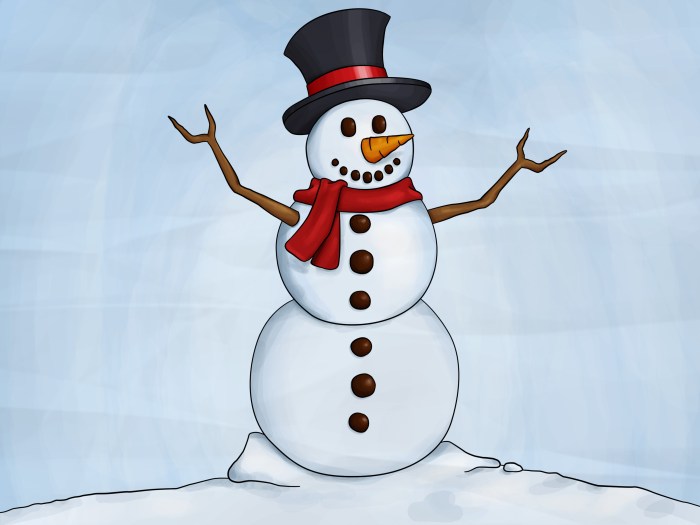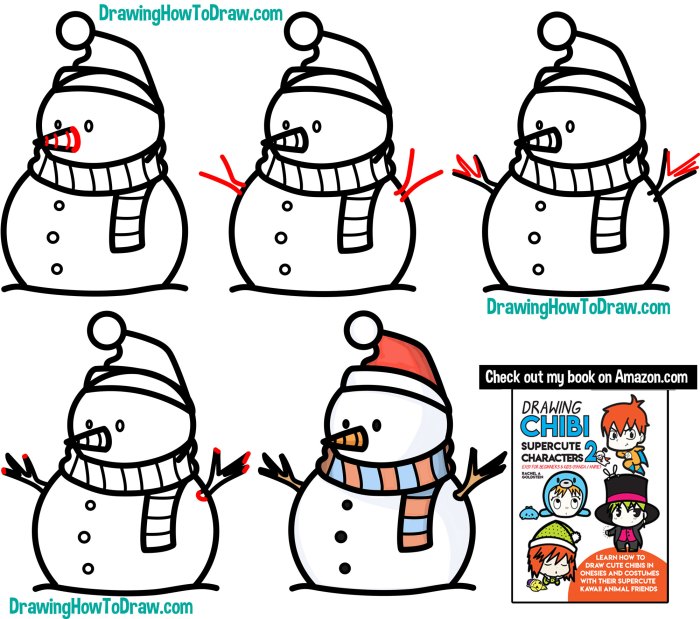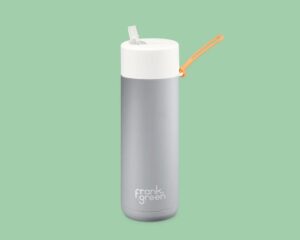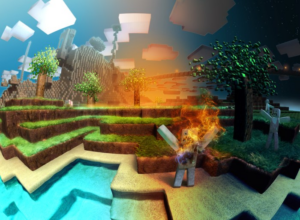3D snowman drawing takes the classic winter icon to a whole new level. It’s not just about capturing a cute, round snowman; it’s about creating a scene that leaps off the page and into your imagination. With a few simple tools and techniques, you can transform flat lines into a frosty masterpiece.
Imagine the satisfaction of seeing your own 3D snowman come to life, complete with fluffy snow, a jaunty hat, and a charming smile.
This guide will walk you through the process, from choosing the right materials to adding the finishing touches. Whether you’re a seasoned artist or just starting out, this journey into 3D snowman drawing is guaranteed to be fun and rewarding.
Get ready to unleash your creativity and embrace the magic of winter in a whole new way.
Introduction to 3D Snowman Drawing
Creating a 3D snowman drawing is a fun and rewarding way to express your artistic creativity. The illusion of depth and realism in these drawings makes them truly captivating. Imagine a snowman seemingly leaping off the page, with its snowy texture and charming details inviting you to reach out and touch it.
The appeal of 3D snowman drawings lies in their ability to bring a familiar winter icon to life.
Examples of Popular 3D Snowman Drawings
The internet is brimming with examples of stunning 3D snowman drawings, each showcasing unique artistic styles and techniques. From simple and whimsical designs to intricate and detailed masterpieces, these drawings demonstrate the versatility of this art form. For inspiration, you can explore online galleries, social media platforms like Pinterest and Instagram, or even visit art exhibitions that feature 3D drawings.
Basic Concepts of 3D Drawing
Understanding the fundamental principles of 3D drawing is essential for creating convincing depth and realism in your snowman artwork. One key concept is perspective, which involves using converging lines to create the illusion of distance and depth. Imagine looking down a long road; the lines of the road seem to meet at a vanishing point in the distance.
Similarly, in 3D drawing, we use converging lines to make objects appear closer or farther away. Another important aspect is shading, which uses variations in tone and color to create the illusion of light and shadow. By carefully shading different areas of your snowman, you can make it appear round and three-dimensional.
Materials and Tools

Before embarking on your 3D snowman drawing journey, it’s crucial to gather the necessary materials and tools. The right equipment can significantly enhance your artistic process and contribute to a satisfying outcome.
Essential Materials
- Drawing Paper:Opt for smooth, heavyweight drawing paper that can handle multiple layers of pencil strokes and erasures.
- Pencils:A set of graphite pencils with varying degrees of hardness is essential for creating different shades and textures. For example, a 2H pencil is good for light sketching, while a 6B pencil can create deep blacks.
- Eraser:Choose a high-quality eraser that effectively removes pencil marks without damaging the paper.
- Blending Tools:Blending stumps, cotton swabs, or even your fingers can be used to soften pencil lines and create smooth transitions between shades.
Types of Drawing Tools for 3D Effects
Various drawing tools can be employed to create 3D effects. Each tool offers unique characteristics that contribute to the final outcome. Here are some popular options:
- Graphite Pencils:These are the most versatile and widely used tools for 3D drawing. They allow for precise control over line thickness and shading.
- Charcoal Pencils:Charcoal pencils produce rich, dark lines that are excellent for creating dramatic shadows and textures.
- Colored Pencils:Colored pencils can add vibrant hues and depth to your snowman drawing. They are particularly useful for creating realistic textures like snow and clothing.
Using Perspective Lines
Perspective lines are crucial for creating the illusion of depth in 3D drawings. By drawing lines that converge towards a vanishing point, you can make objects appear closer or farther away. To illustrate this concept, imagine drawing a simple snowman.
Start by sketching two circles for the body, one slightly larger than the other. Then, draw lines from the top and bottom of each circle towards a vanishing point located outside the drawing area. These converging lines create the illusion that the snowman is receding into the distance, giving it a three-dimensional appearance.
Creating the Snowman Base: 3d Snowman Drawing
The foundation of your 3D snowman drawing lies in creating a solid and convincing base. This involves crafting a shape that embodies the roundness and volume of a real snowman.
Drawing a Basic Snowman Shape, 3d snowman drawing
Start by lightly sketching two overlapping circles on your drawing paper. The top circle should be smaller than the bottom circle, representing the head and body of the snowman. Make sure the circles are slightly overlapping to create a smooth transition between the head and body.
Once you’re satisfied with the placement, you can refine the shapes and create a more rounded, organic appearance. Remember, the goal is to create a base that looks three-dimensional.
Adding Volume and Dimension

To enhance the 3D effect, use shading techniques to create the illusion of light and shadow on the snowman’s base. Begin by identifying the areas that would be most illuminated by a light source. These areas should be left lighter, while the areas that would be in shadow should be shaded darker.
You can use a variety of shading techniques, such as hatching, cross-hatching, or blending, to create different levels of depth and texture. For example, you could use light strokes to create the smooth texture of snow, while darker strokes could be used to represent the shadows cast by the snowman’s body.
Creating a Stable and Balanced Snowman
To ensure your snowman appears stable and balanced, consider the weight distribution. The base of the snowman should be wider than the top to create a solid foundation. You can also add subtle details like a slight tilt or a slight curve to the base to enhance the sense of stability.
Remember, a balanced snowman will look more realistic and engaging.
Adding Details and Features
Once you have a solid base, it’s time to bring your snowman to life with charming details and features. These elements add personality and whimsy to your drawing, transforming it from a simple shape into a delightful character.
Adding Eyes, Nose, and Mouth
Start by adding a pair of eyes. These can be simple black dots or more detailed shapes like circles with small highlights to create a sense of depth. For the nose, you can draw a classic carrot shape or experiment with other creative options like a button or a twig.
The mouth can be a simple smile or a more expressive frown, depending on the personality you want to convey. Remember to consider the overall composition of the face and ensure the features are balanced and proportionate.
Creative Hat and Scarf Designs
Hats and scarves add a touch of personality and warmth to your snowman. Explore different hat designs, from a classic top hat to a cozy beanie or a playful bucket hat. You can add details like a pom-pom or a ribbon to further enhance the design.
For scarves, consider a simple loop or a flowing design with intricate patterns. The possibilities are endless, so let your imagination run wild!
Creating Realistic Textures
Adding realistic textures to your snowman’s clothing and snow can elevate your drawing to a whole new level. For snow, use light strokes and blending techniques to create a soft, powdery texture. To depict the texture of a scarf, you can use a variety of techniques like cross-hatching or stippling to create a rough, woven appearance.
For a hat, you could use a combination of shading and highlighting to create a sense of fabric and detail. Remember, the key is to observe real-life textures and translate them into your drawing using various pencil techniques.
Creating a 3D Background
A compelling 3D background adds depth and context to your snowman drawing, placing it within a realistic winter scene. By creating a sense of space and environment, you enhance the overall impact and visual storytelling of your artwork.
Techniques for a Realistic Snowy Background
To create a realistic snowy background, use a combination of shading, perspective, and detail. Start by drawing a horizon line to define the separation between the ground and the sky. Then, use light shades of gray or blue to create a sense of distance and depth in the sky.
For the ground, use a slightly darker shade of gray or blue and gradually darken it as it recedes into the distance. This creates a sense of perspective and makes the background appear to extend beyond the edges of your drawing.
Adding Elements to the Background
Incorporate elements like trees, houses, or mountains to add visual interest and depth to your background. To create trees, use a combination of dark and light lines to represent branches and foliage. You can use perspective lines to make the trees appear farther away.
For houses, use simple shapes and shading to create a sense of volume and depth. Mountains can be created by drawing a series of overlapping shapes that gradually get smaller as they recede into the distance.
Using Perspective for Background Depth
Perspective plays a crucial role in creating depth in your background. Use converging lines to make objects appear closer or farther away. For example, if you are drawing a snowy path, you can use converging lines to make it appear to extend into the distance.
This creates a sense of space and depth, making your snowman drawing feel more immersive.
Finishing Touches and Enhancements

To complete your 3D snowman drawing and elevate it to a professional level, add finishing touches and enhancements that bring out the subtle details and create a sense of realism. These final steps can make a significant difference in the overall impact of your artwork.
Adding Shadows and Highlights
Shadows and highlights are essential for creating a three-dimensional appearance. Identify the areas of your snowman that would be in shadow, such as the underside of the head or the back of the body. Use darker shades to create these shadows.
Conversely, identify the areas that would be most illuminated by a light source and use lighter shades to create highlights. These subtle variations in tone will give your snowman a more realistic and rounded appearance.
Incorporating Color and Texture
Adding color and texture can further enhance the realism and visual appeal of your snowman drawing. For example, you can use a light blue color to create the icy texture of snow, or you can use a warm brown color to create the texture of a wooden stick used for the snowman’s arms.
You can also use different shades of color to create depth and dimension in the snowman’s clothing and accessories. For example, you could use a darker shade of blue for the shadow side of a blue scarf and a lighter shade for the illuminated side.
Importance of Composition and Framing
Composition and framing are crucial aspects of creating a visually appealing and impactful artwork. Consider the placement of your snowman within the drawing space. A well-balanced composition will create a sense of harmony and visual interest. Experiment with different framing techniques to find the most compelling arrangement.
For example, you could place the snowman in the center of the drawing for a symmetrical composition, or you could place it off-center for a more dynamic and asymmetrical look. Remember, the goal is to create a composition that draws the viewer’s eye to the subject and enhances the overall impact of your artwork.
Last Recap
As you master the art of 3D snowman drawing, you’ll discover a world of possibilities. You’ll be able to create stunning snow scenes, experiment with different perspectives, and even add your own unique flair. So, grab your pencils, embrace the challenge, and let your imagination run wild.
With a little practice and a whole lot of fun, you’ll be creating 3D snowmen that are as captivating as the winter wonderland they inhabit.
FAQ
What are some popular 3D snowman drawing styles?
There are many! You can go for a realistic style, a whimsical style, or even a cartoonish style. It all depends on your personal preference.
How can I make my 3D snowman drawing look more realistic?
Pay attention to details like shadows, highlights, and textures. Use different shades of gray to create depth and dimension.
What are some tips for drawing a 3D snowman background?
Use perspective lines to create a sense of depth. Add elements like trees, houses, or mountains to make the scene more interesting.
What are some creative ideas for snowman accessories?
Get creative! Think about different types of hats, scarves, and even buttons. You can even add a carrot nose, a twig for arms, and a bucket for a hat!





